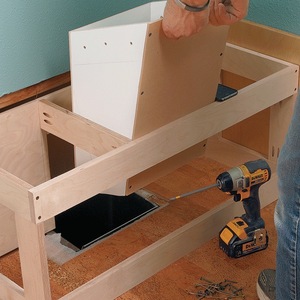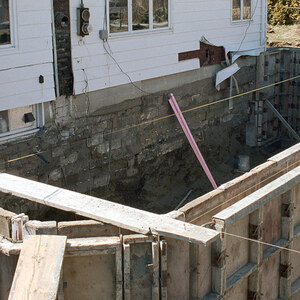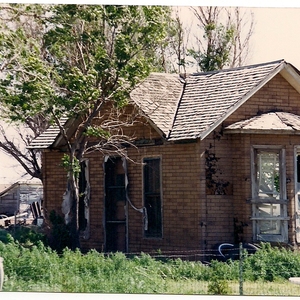We’re replacing the outdoor cable, which is in sections, so it will be one continuous run of about 100 feet. But what type of cable should we use? When I asked at a store, they said they carried only two kinds of cable, “black or white.”
Well, at least they gave me a sample to take home. It was labeled
AMPHENOL CTFC-T10 4002132 6 SERIES (ETL)US BLX,CATV 18 AWG 75C 100V 282 FEET
It appears to be dual-shield.
Then I found this on the Family Handyman site:
Skip the economy cable and go right for the “quad-shield” product. Quad-shield costs twice as much as cable labeled “dual” or “double-shield.” But after spending big bucks on your TV or computer, skimping on coax just doesn’t make sense.
The article could well be obsolete (there was no date), so I asked a Verizon tech about quad-shield cable:
Verizon has never uses quad-shield. It is a waste of money, and it is almost impossible to get the connectors on [it is slightly thicker but uses the same connectors as RG-6]. Besides, it doesn’t make sense to install it now, given that in about ten years all service will be wireless.
He could just as well say there will be starship engines the size of walnuts. I don’t know about predictions. Ten years ago, I was advised to wire my home with expensive fiber-optic cable because it would be replacing coax. That doesn’t seem likely now.
What type of cable would you use?
Janet


















Replies
There are several criteria that define coax cable:
Impedance. Common coax impedance ("nominal") values are 50 ohms, 75 ohms, and 92 ohms. Coax for TV antennas and "cable" feeds is pretty much always 75 ohms. (50 ohm is used, eg, to feed non-RF video signals between a VCR and a TV, and for that use is usually terminated with "RCA" connectors.)
Jacket composition. Most standard TV-rated coax is suited for outdoor use, but not all. Some cable is rated for direct burial or underwater use. Also, some jackets are "plenum rated", meaning they do not give off noxious gasses (very much) in a fire and hence can be routed through ceilings that serve as return air ducts, etc. I'd generally trust a good, standard jacket brand-name cable (Amphenol, Alpha, Carrol, et al) that doesn't come labeled for "interior use only" or some such.
Shielding. Standard shielding is a braid of copper wire surrounding the central wire. But this can be very loose and porous, "tight", double (or more) layered, or foil can be used instead of/in addition to the wire braid. The main issue here is interference. If the cable, eg, runs parallel to the power wires serving the house then you want a hair more shelding since the power wires carry noise. Conversely, a cable running from rooftop antenna down doesn't need to be shielded quite as much for the simple reason that any noise source will have gotten into the antenna anyway. And the issue is not so much the number of layers of shielding as how well the layers work. A single good layer is better than two poor layers. And lots of layers are a minus if you can't get the connectors on properly.
Diameter. This determines what size connectors fit the wire. The common 75 ohm sizes are RG-59 (smaller) and RG-6 (larger). There is an even larger RG-11 but it's rarely used. RG-59 has a hair more internal resistance (ie, more signal loss) than RG-6, but the difference isn't enormous. (When buying "F" connectors for the ends of the cable, make sure you get the right size)
Color is slightly signinifcant in that a black cable will generally hold up to sunlight damage better than other colors.
I am not sure a phone company is the best source of information about cable. The cable companies pretty much all use quad shield. They also have the right connectors and the tool to pop them on.
For the home owner, you have to ask what you are sending down that cable.
If this is an antenna cable, just about and decent coax will work RG-6 or even RG-59 (which uses different connectors).
If this is cable, why isn't the cable company replacing it? they usually want their techs doing it to prevent "ingress" on their plant.
I think I would use quad shield if I had "cable" in the house but I am using regular RG-6 to distribute the UHF signals from my satellite box (RF out)
BTW the "internet" signal is not as picky as a high channel HD picture. Usually the internet on a cable system is VHF down around channel 5 in the low band.
As for Verison, they are actively trying to get everyone on fiber and any "copper" advice I took them would come with a hefty kosher sized grain of salt. The strange thing is my Telco is pushing internet and TV service down cat 3 twisted pair. They are going through cleaning up their plant but is is still cat 3 at best.
It wasn't the Verizon phone company; it was Verizon FiOS. My next-door neighbor is installing their combination Internet/television/telephone service.
We have Optimum cablevision for Internet/television/telephone. They are the ones who only knew cable as being "black" or "white". We get lousy Wi-Fi Internet, but I suppose that is due to the router, not the cable.
Television picture is okay. Does that mean I don't need to upgrade to quad-shield?
One reason I am replacing the cable is because we are having the house painted. The existing cable is in sections and covered with cracked layers of paint, so it seems like a logical time to do replace it, even though it is working okay.
Verison is still a phone company. They are just trying to be a multimedia company. I imagine any TV distribution beyond their FiOS box is VHF so they are not that picky on what cable is being used.
I also bet all of the cable your cable company uses is quad shield, either in white or black. I would call them and bug them about the internet service. It shares the TV cable but it is a separate service and they may have some bad equipment somewhere. Usually they will replace cable if they think that is the problem. You might want to start there.
It wasn't the Verizon phone company; it was Verizon FiOS. My next-door neighbor is installing their combination Internet/television/telephone service.
We have Optimum cablevision for Internet/television/telephone. They are the ones who only knew cable as being "black" or "white". We get lousy Wi-Fi Internet, but I suppose that is due to the router, not the cable.
Television picture is okay. Does that mean I don't need to upgrade to quad-shield?
One reason I am replacing the cable is because we are having the house painted. The existing cable is in sections and covered with cracked layers of paint, so it seems like a logical time to do replace it, even though it is working okay.
If "the existing cable is in
If "the existing cable is in sections" that's a good reason to replace it. You really want to minimize splices in RF cables.
Do it right and be done with it.
FWIW, I spent 20 years selling and installing A/V.
Spend the money and get the Quad shield. In many environments, it will improve your cable picture on the broadcast channels due to the superior shielding. There may be other benefits as well. You can't see r/f (radio frequency) pollution, but it increases every year. Better to have the maximum shield present.
Yes, you do want the high contact connectors that do require a special tool to install. Shielded cable is worthless without a proper connection.
Yes, you are well served to try and get the supplier to replace the cable. Baring that, look for one of their installers trucks and ask the guy, "Would like to make some extra bucks in cash?". They have a nasty job and are always looking for a bit of extra sugar. They also have the cable, connectors and tools.
Strongly consider laying down multiple cables. You might decide to convert to Direct TV for the superior picture quality and selection. There are currently 4 RG6 cables from my dish to the box, at some point it will grow to more.
Everybody in A/V hates the cable company, there must be a reason. Regrettably, AT&T has devolved to their level. Their people may be more articulate, but they still can't get anything done correctly. It took them 5 full days to diagnose that my DSL had died due to a defective component in their office. That's 5 full days of either 2 or 3 of their union techs in my home to determine the problem was on their end.
Not that I am bitter or anything. :)
Good Luck.
Do you know anything about this cable and its connectors? Monoprice - 100ft RG6 (18AWG) 75Ohm, Quad Shield, CL2 Coaxial Cable with F Type Connector - White - White
I figured I'd be better off buying cable that already had the connectors on it. I don't know anything about Monoprice—I got to it via a link at Best Buy—but it appears to be the name of the seller, not the manufacturer. If it had been made by a decent manufacturer, they'd have mentioned it, right?
Janet
Your garden-variety drugstore coax. Probably will do the job, but not a high confidence level.
That looks like it will work and if it is about the right length you are good to go. A little extra will not hurt you but you don't want a big coil of extra coax Some say you are a lot better off wrapping the extra back and forth instead of coiling it but I was never able to prove that with TDR. You can put reflections in the cable with sharp bends so keep it loose and do not crush it with staples that are too tight. When I was doing the TDR demo with a scope, I could show guys a crushed coax, plain as day. Once you king or crush it, you will never get that glitch to completely disappear. .
Yeah, within reason (5-15 feet on a 100-foot run) coiling the wire should not be a serious problem. Just keep the coil away from power cables and such. Do try to avoid splices/joints, especially out of doors.
Outdoor rated?
You want an outdoor rated cable. I don't know if this is. I would ask.
FWIW, the online a/v install community says bad things about monoprice.
Good luck.
Yeah, I have a general rule that when I install low-voltage cables I install one or two spares. It's generally very little added effort, and the price of the cable isn't that big a deal.
"Outside" use requires two
"Outside" use requires two things: rated cable and rated connectors. You'll probably do fine with whatever cable you use, but the connectors are another story. The only connectors that are truely suitable for outdoor use are the 'compression' type that require a special tool to install. Crimp-on and screw-on just won't keep water out of the connector / cable connection.
Expect to pay about $80 for a compression tool, a stripper, and a handful of connectors.
Size matters. Make sure you have RG-6, and not the smaller diameter RG-59. Within a house, the smaller cable is just fine.
Most coax is simply a cable; for overhead spans there is a version that incorporates a steel wire alongside the coax to take the load off of the coax itself.
Far more important is the manner of installation. You want a layout where every jack is run straight back to the cable box - you don't want to branch off / tap / split the wire along the way.